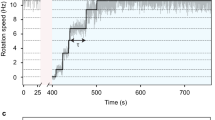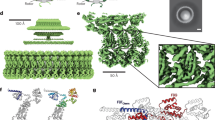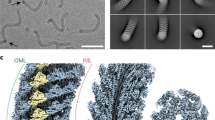Abstract
ROTARY motors of bacterial flagella are driven by ions that move across the cytoplasmic membrane down an electrochemical gradient1–4. For Escherichia coli, the ions are protons, and the maximum work per unit charge that they can do is the proton-motive force. To test whether motor efficiency is limited by proton leakage or mechanical nonlinearities, we measured torque as a function of protonmotive force. Filamentous cells were drawn into micropipettes and energized with an external voltage source. Torque was proportional to protonmotive force up to –150 mV, twice the span accessible by earlier techniques5–9. This is consistent with a mechanism in which a fixed number of protons, working at unit efficiency, carry the motor through each revolution. We also found that individual torque-generating elements inactivate at low potentials or potentials of reverse sign. When normal potentials are restored, they reactivate sequentially.
This is a preview of subscription content, access via your institution
Access options
Subscribe to this journal
Receive 51 print issues and online access
$199.00 per year
only $3.90 per issue
Buy this article
- Purchase on Springer Link
- Instant access to full article PDF
Prices may be subject to local taxes which are calculated during checkout
Similar content being viewed by others
References
Blair, D. F. Semin. Cell Biol. 1, 75–85 (1990).
Jones, C. J. & Aizawa, S.-I. Adv. microb. Physiol. 32, 109–172 (1991).
Macnab, R. M. A. Rev. Genet. 26, 131–158 (1992).
Schuster, S. C. & Khan, S. A. Rev. Biophys. biomolec. Struct. 23, 509–539 (1994).
Manson, M. D., Tedesco, P. M. & Berg, H. C. J. molec. Biol. 138, 541–561 (1980).
Conley, M. P. & Berg, H. C. J. Bact. 158, 832–843 (1984).
Khan, S., Meister, M. & Berg, H. C. J. molec. Biol. 184, 645–656 (1985).
Meister, M. & Berg, H. C. Biophys. J. 52, 413–419 (1987).
Meister, M. thesis, California Inst. Technol., Pasadena, CA (1987).
Katsu, T., Kobayashi, H. & Fujita, Y. Biochim. biophys. Acta 860, 608–619 (1986).
Ovchinnikov, Y. A. & Ivanov, V. T. in The Proteins 3rd edn Vol. 5 (eds Neurath, H. & Hill, R. L.) 307–642 (Academic, New York, 1982).
Fung, D. C. Y. K. thesis, Harvard Univ., Cambridge, MA (1994).
Block, S. M., Blair, D. F. & Berg, H. C. Nature 338, 514–517 (1989).
Block, S. M., Blair, D. F. & Berg, H. C. Cytometry 12, 492–496 (1991).
Block, S. M. & Berg, H. C. Nature 309, 470–472 (1984).
Blair, D. F. & Berg, H. C. Science 242, 1678–1681 (1988).
Armitage, J. P. & Evans, M. C. W. Biochim. biophys. Acta 806, 42–55 (1985).
Ravid, S. & Eisenbach, M. J. Bact. 158, 222–230 (1984).
Berg, H. C., Manson, M. D. & Conley, M. P. Symp. Soc. exp. Biol. 35, 1–31 (1982).
Khan, S. & Berg, H. C. Cell 32, 913–919 (1983).
Khan, S., Dapice, M. & Humayun, I. Biophys. J. 57, 779–796 (1990).
Kami-ike, N., Kudo, S. & Hotani, H. Biophys. J. 60, 1350–1355 (1991).
Meister, M., Lowe, G. & Berg, H. C. Cell 49, 643–650 (1987).
Berg, H. C. & Turner, L. Biophys. J. 65, 2201–2216 (1993).
Kashket, E. R. A. Rev. Microbiol. 39, 219–242 (1985).
Ishihara, A., Segall, J. E., Block, S. M. & Berg, H. C. J. Bact. 155, 228–237 (1983).
Berg, H. C. & Turner, L. Biophys. J. 58, 919–930 (1990).
Brown, K. T. & Flaming, D. G. Advanced Micropipette Techniques for Cell Physiology (Wiley, Chichester, 1986).
Author information
Authors and Affiliations
Rights and permissions
About this article
Cite this article
Fung, D., Berg, H. Powering the flagellar motor of Escherichia coli with an external voltage source. Nature 375, 809–812 (1995). https://doi.org/10.1038/375809a0
Received:
Accepted:
Issue Date:
DOI: https://doi.org/10.1038/375809a0
This article is cited by
-
Cable bacteria with electric connection to oxygen attract flocks of diverse bacteria
Nature Communications (2023)
-
Torque, but not FliL, regulates mechanosensitive flagellar motor-function
Scientific Reports (2017)
-
A 3D Motile Rod-Shaped Monotrichous Bacterial Model
Bulletin of Mathematical Biology (2009)
-
Direct observation of steps in rotation of the bacterial flagellar motor
Nature (2005)
-
DNA transport into Bacillus subtilis requires proton motive force to generate large molecular forces
Nature Structural & Molecular Biology (2004)
Comments
By submitting a comment you agree to abide by our Terms and Community Guidelines. If you find something abusive or that does not comply with our terms or guidelines please flag it as inappropriate.



